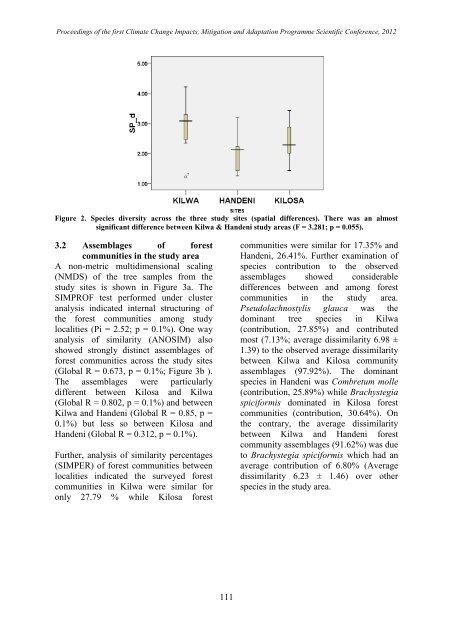Preliminary Assessment of Forest Structure.pdf - Sokoine University ...
Preliminary Assessment of Forest Structure.pdf - Sokoine University ...
Preliminary Assessment of Forest Structure.pdf - Sokoine University ...
You also want an ePaper? Increase the reach of your titles
YUMPU automatically turns print PDFs into web optimized ePapers that Google loves.
Proceedings <strong>of</strong> the first Climate Change Impacts, Mitigation and Adaptation Programme Scientific Conference, 2012Figure 2. Species diversity across the three study sites (spatial differences). There was an almostsignificant difference between Kilwa & Handeni study areas (F = 3.281; p = 0.055).3.2 Assemblages <strong>of</strong> forestcommunities in the study areaA non-metric multidimensional scaling(NMDS) <strong>of</strong> the tree samples from thestudy sites is shown in Figure 3a. TheSIMPROF test performed under clusteranalysis indicated internal structuring <strong>of</strong>the forest communities among studylocalities (Pi = 2.52; p = 0.1%). One wayanalysis <strong>of</strong> similarity (ANOSIM) alsoshowed strongly distinct assemblages <strong>of</strong>forest communities across the study sites(Global R = 0.673, p = 0.1%; Figure 3b ).The assemblages were particularlydifferent between Kilosa and Kilwa(Global R = 0.802, p = 0.1%) and betweenKilwa and Handeni (Global R = 0.85, p =0.1%) but less so between Kilosa andHandeni (Global R = 0.312, p = 0.1%).Further, analysis <strong>of</strong> similarity percentages(SIMPER) <strong>of</strong> forest communities betweenlocalities indicated the surveyed forestcommunities in Kilwa were similar foronly 27.79 % while Kilosa forestcommunities were similar for 17.35% andHandeni, 26.41%. Further examination <strong>of</strong>species contribution to the observedassemblages showed considerabledifferences between and among forestcommunities in the study area.Pseudolachnostylis glauca was thedominant tree species in Kilwa(contribution, 27.85%) and contributedmost (7.13%; average dissimilarity 6.98 ±1.39) to the observed average dissimilaritybetween Kilwa and Kilosa communityassemblages (97.92%). The dominantspecies in Handeni was Combretum molle(contribution, 25.89%) while Brachystegiaspiciformis dominated in Kilosa forestcommunities (contribution, 30.64%). Onthe contrary, the average dissimilaritybetween Kilwa and Handeni forestcommunity assemblages (91.62%) was dueto Brachystegia spiciformis which had anaverage contribution <strong>of</strong> 6.80% (Averagedissimilarity 6.23 ± 1.46) over otherspecies in the study area.111
















